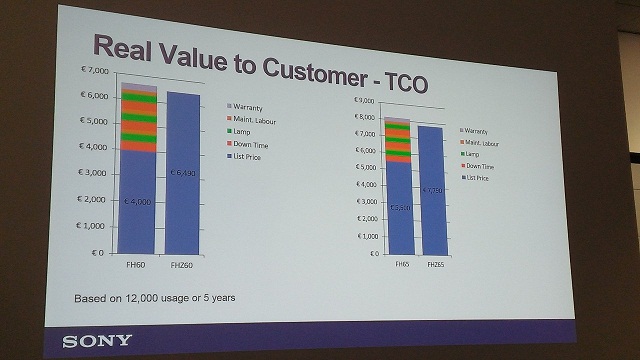Sony was the first meeting of the day, taking place at the Brooklands Museum, next to Mercedes-Benz World. Rob Meakin, European product marketing manager for professional projectors, was discussing the company’s work with laser projectors.
Sony has a long history in projection, working with 3LCD and its own SXRD (based on LCoS) technologies. The company developed its BrightEra tech several years ago, for its 3LCD projectors, which is designed to raise brightness and colour accuracy while lowering burn-in. 3LCD panels can now be used for up to 25,000 hours without burn-in, and Sony likes to think that the differences between DLP and 3LCD have been minimised.
Meakin explained some of the issues behind the laser-LED hybrid light sources that are seen on some of today’s projectors. There are limits on the brightness, due to the ‘LED bottleneck’ (LEDs are inefficient, and require a lot of power for high brightness); they suffer from light scatter (leakage); and have low colour brightness, due to the use of DLP technology. In case you were wondering, ‘colour brightness’ is a term often used by Epson – both companies are part of the 3LCD Consortium, although Sony is a silent partner.
 Sony believes that laser is the right technology for 4,000+ lumen projectors, which hybrid light sources ‘struggle’ to reach for colour brightness. The company has introduced laser models at this brightness already – its first laser projector, the VPL-FHZ55, debuted at ISE 2013 (Display Monitor Vol 21 No 6) – and plans to go up from here. A slide showed plans for new 6,000- and 5,000-lumens laser- and lamp-based ‘WXGA’ (this can refer to multiple different resolution) models in February next year, and laser-based projectors with 1920 x 1200 resolution in Q4’16.
Sony believes that laser is the right technology for 4,000+ lumen projectors, which hybrid light sources ‘struggle’ to reach for colour brightness. The company has introduced laser models at this brightness already – its first laser projector, the VPL-FHZ55, debuted at ISE 2013 (Display Monitor Vol 21 No 6) – and plans to go up from here. A slide showed plans for new 6,000- and 5,000-lumens laser- and lamp-based ‘WXGA’ (this can refer to multiple different resolution) models in February next year, and laser-based projectors with 1920 x 1200 resolution in Q4’16.
Meakin pointed out that DLP projector makers are now also tending to steer away from hybrid laser-LED light sources. A new trend is to use a blue laser with a red/green/transparent colour wheel and a yellow phosphor, producing RGBY colours.
Educational institutions are one of the main customers of laser projectors – they tend to be very early adopters. However, there have been challenges in getting these customers to buy laser projectors, which have a higher up-front cost than lamp-based models. The main advantages to laser projectors are the lack of maintenance and down-time from lamp replacements – but it is difficult to convince buyers, as the budgets for new projectors and for maintenance are often handled by different departments! This is changing slowly, however.
Some time was spent on the VPL-FHZ65 and VPL-FHZ60 – these are this year’s new B2B laser projectors, first seen at ISE 2015 (Sony Invests in Lasers). The FHZ65 was launched in August, for €6,550 ex VAT, and the FHZ60 will be introduced this month, for €5,455 ex VAT. Lamp-based equivalents (FH65/FH60) will be introduced in November and December, respectively.
The new projectors are for educational and corporate clients – about 80% of the UK’s laser projector business comes from education. However, new markets are being opened up as laser technology develops, such as signage; corporate atriums; and museums. Because of this, Sony is extending its laser projector warranty to five years, or 20,000 hours.
Meakin also mentioned a laser projector called the VPL-FHZ57, which will replace the FHZ55. It will feature a new chassis design, with cable ports to the side, not rear, and a cover. Sony’s new Reality Creation, Contrast Enhancer and Picture Performance technologies, which were introduced on the FHZ65/FHZ60, will also be featured.
On the main floor of the show, Sony was demonstrating the FHZ65/FHZ60 laser projectors, as well as the X900C LCD TV (Sony’s TV is Slimmer Than a Smartphone).

